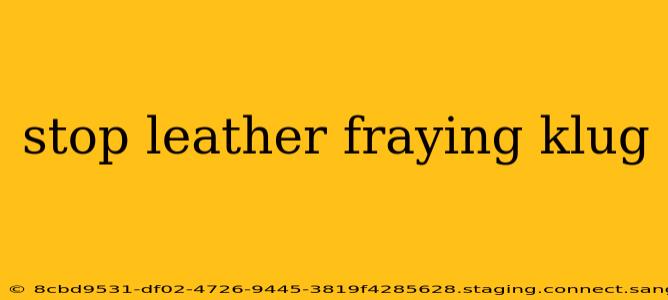Stop Leather Fraying: A Comprehensive Guide to Preserving Your Klug Leather Goods
Leather, a material prized for its durability and timeless appeal, is nonetheless susceptible to fraying, especially at edges and seams. This is particularly true for high-quality, full-grain leather goods like those from Klug, which often feature intricate stitching and detailed designs. Understanding the causes of fraying and implementing preventative measures can significantly extend the lifespan of your valued leather items. This guide will explore effective methods to stop leather fraying, focusing on techniques applicable to Klug and similar high-end leather products.
What Causes Leather Fraying?
Before diving into solutions, it's crucial to understand why leather frays. Several factors contribute to this issue:
- Natural Wear and Tear: Everyday use, friction, and bending can gradually weaken the leather fibers, leading to fraying, especially at stress points like edges and corners.
- Moisture and Humidity: Exposure to excessive moisture can weaken leather fibers, making them more prone to fraying and damage.
- Improper Care: Neglecting proper cleaning and conditioning can leave leather dry and brittle, increasing its susceptibility to fraying.
- Manufacturing Defects: While less common with reputable brands like Klug, manufacturing imperfections can sometimes predispose leather to fraying.
How to Prevent Leather Fraying: Proactive Measures
Prevention is key when it comes to leather care. By adopting these proactive measures, you can significantly reduce the risk of fraying:
- Regular Conditioning: Keep your Klug leather goods supple and hydrated by regularly applying a high-quality leather conditioner. This will prevent dryness and brittleness, two major contributors to fraying.
- Proper Storage: Store your leather items in a cool, dry place, away from direct sunlight and extreme temperatures. Using dust bags or protective covers can also help prevent scratches and abrasion.
- Gentle Handling: Avoid harsh rubbing or pulling on your leather goods. Handle them gently and carefully to minimize stress on the leather fibers.
- Immediate Cleaning: Address spills and stains promptly to prevent them from setting and damaging the leather.
Addressing Existing Fraying: Repair and Restoration
If your Klug leather goods already exhibit fraying, don't despair. Several methods can help address the issue:
- Leather Sealant: Applying a leather sealant to frayed edges can help reinforce the fibers and prevent further damage. Choose a sealant specifically designed for leather and apply it sparingly according to the manufacturer's instructions.
- Leather Repair Kit: For more significant fraying, a leather repair kit can be a valuable tool. These kits often contain adhesives, dyes, and tools to mend tears and reinforce damaged areas.
- Professional Repair: For particularly intricate or valuable items, consider seeking professional leather repair services. A skilled craftsman can expertly address fraying and restore the leather's appearance.
How Can I Protect the Edges of My Klug Leather Goods?
Protecting the edges is crucial in preventing fraying. Beyond conditioning and careful handling, consider:
- Edge Paint or Dye: Some leatherworkers use edge paint or dye to seal and protect the edges, adding a layer of durability and enhancing the aesthetic appeal.
- Protective Coatings: Specialized sprays or waxes can offer a protective barrier against moisture and abrasion. Apply them sparingly and evenly to prevent build-up.
What are the best cleaning products for Klug leather?
Always use cleaning products specifically designed for leather. Avoid harsh chemicals, abrasive cleaners, and excessive moisture. A soft cloth, lukewarm water (if necessary), and a mild leather cleaner are usually sufficient for spot cleaning. For deep cleaning, consult a professional leather cleaner.
How often should I condition my Klug leather?
The frequency of conditioning depends on several factors including climate, usage, and leather type. As a general rule, conditioning every 3-6 months is a good starting point. However, if the leather feels dry or stiff, it's time for conditioning.
By following these tips and adopting a proactive approach to leather care, you can significantly extend the lifespan of your Klug leather goods, ensuring they remain beautiful and functional for years to come. Remember, preventative care is far more effective and less costly than repairing extensive damage.

